| Sep-03-04 | | wall: Does White have any winning chances with 50.e6+ Kf6 51.e7 Kf7 52.f6 instead of 50.Kg3 as in the game? Another game with bishops of opposite color. It looks risky after 53.Bb4, and White lost another pawn. Why not 53.Bc7 and hold the pawn? |
|
| Oct-09-04 | | Hanzo Steel: If 10. ... ♕xc3, then 11. e5 ♘g8 (... ♘h5?! 12. ♖c1 ♕a3 13. ♘c2) 13. ♕g4 ♔f8 14. ♕h4, with significant advantage threatening mate on d8. |
|
| Oct-09-04 | | Hanzo Steel: Why not 15. fxe5 ♕xe5 16. ♘f5 ♗xf5 17. ♖xf5 ♕e6 18. ♗d4 0–0 19. ♗xf6 gxf6 20. ♕g4+ ♔h8 21. ♕h4, which will win a pawn at least? It seems to me that Fischer has an advantage in the opening, because of a huge lead in development, but he squanders it somewhat. 7. ... Qb6 seems like an unsound novelty from Reshevsky, who's been known to play shaky openings. I mean, he moves his queen 5 times in the first 13 moves before castling or activating his knight or bishop, while Fischer has castled to safety and has all his pieces already in the fight. |
|
| Oct-09-04 | | Hanzo Steel: <wall> 51. ... ♗c6 seems to stop that attack dead. Maybe there's something else? |
|
| Nov-29-05 | | yoshi927: Instead of 38 Bxe5, why not 38 Bxc4. The Knight is less useful to black than the bishop, and though it does have a check, it can be taken if it uses it. And plenty of time to take down the Knight with 2 Bishops on your side. |
|
Apr-15-08
 | | ketchuplover: 2 bishops? |
|
| Aug-26-11 | | Highlander18: Hanzo Steel, Reshevsky would have answered 15.fxe5 with ...Ng4, not 15...Qxe5. |
|
Aug-26-11
 | | Sastre: <yoshi927: Instead of 38 Bxe5, why not 38 Bxc4> After 38.Bxc4+ Nxc4, White loses a pawn. If 39.a4, 39...Nd2 (40.e5 fxe5 41.Bxe5 Ke6 42.c6 bxc6) 40.Kf2 Nxe4+  . . |
|
| Jun-16-15 | | RookFile: Played over this game again tonight. Reshevsky's opening play seems really dubious to me. If he tried this against Fischer just a few years later he would have been crushed. He puts his pawns on white squares, then brings out the dark squared bishop and trades it off. Meanwhile black's queen is making umpteen moves in the opening. I think Reshevsky was trying to bait Fischer into doing something rash but he came real close to getting into serious trouble in this game. |
|
| Sep-10-20 | | pepechuy: Did Fischer really play 57. Kg1 ?
I am not implying it is a bad move, I am asking a question.
In the book "The best endings of Capablanca and Fischer", 57. Kh1 is given. |
|
Oct-23-22
 | | KEG: Going into this third round game, Resheveky was tied for first (at 2-0) with Sherwin. Bobby Fischer was one of three players a half-point behind. At this stage, and given that Fischer had scored 4.5-6.5 in the 1956 Rosenwald (not technically considered an official "US Championship for reasons I have never been able to fathom) and had lost his individual game to Reshevsky, I doubt anyone considered this 14-year old to be a serious contender for first place at this point. Indeed, Reshevsky seemed comfortable in taking liberties in the opening against his young opponent. I agree with <RookFile> that had Reshevsky played this way against Fischer a few years later he would have been crushed. Despite the fact that Fischer drew this game and eventually won the tournament a point ahead of Reshevsky, Sammy was probably a stronger player at this time. That would not remain the case very long (but we must recall that the Fischer-Reshevsky match a few years later was even at two wins each before Bobby defaulted). My quibbles aside, and although Bobby was not yet the world-beater he would become, this is an engrossing struggle to play over. 1. e4 c5
2. Nf3 e6
3. d4 dxc4
4. Nxd4 a6
The Kan Variation, which Reshevsky played again in Round 8 in his win over Bisguier. It has the merit of flexibility, but Black's development lags. A good try by Reshevsky to try to confuse his 14-year old opponent. 5. c4
In his commentary on this game Fischer said he was trying to get a "type of Maroczy bind." 5. Nc3 and 5. Bd3 are more usual, but the text is also good. 5... Nf6
6. Nc3
Fischer said that he was willing to have his c-pawns doubled in return for getting the two Bishops and more rapid development. 6... Bb4
Reshevsky was game to give Fischer doubled pawns. 7. Bd3

click for larger view7... Qb6?!
"?"--(Fischer)
"?!"--(Muller)
A move that, to my knowledge, was never played before and has not been tried since. It appears that Resheveky was "messing" with Bobby, perhaps thinking he could get away with unsound play and recover even if this led to trouble for Black. 8. Be3 BxN+
9. bxB
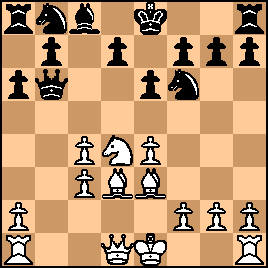
click for larger viewSo both side got what they wanted. Objectively, White is better, but perhaps notnin 1957 against Reshevsky. Black, again speaking strictly objectively, should back off with 9...Qc7. But Reshevsky was not done messing around yet. 9... Qa5?!
10. 0-0!
A cool, collected, and excellent reply by Bobby: 
click for larger view10... d6
As both Fischer and Muller point out in their commentaries on this game, 10...Qxc3? wound run into 11. e5. <Hanzo Steel> has given a likely continuation after 11. e5, with which I agree except that even better than 13. Qh4 are 13. Rad1, 13. Rfd1 and 13. Qe2 (but all three moves probably win). 11. c5!
"!"--(Fischer)
"?!"--(Muller)
Muller's 11. Nb3 is also excellent and arguably even objectively stronger, but I prefer the tactically tricky text whatever the computers may say). The position was now:

click for larger view |
|
Oct-23-22
 | | KEG: Post II
11... Qc7?
Fischer claimed that 11...dxc5 would be a mistake in light of 12. Nb3 Qc7 13. Bxc5. Muller extended this analysis to include 13...Nbd7 14. Bb4. And it is true that White is much better in this line and that "Black's King is trapped in the center" (Fischer) and White has "annoying pressure on the dark squares [since Reshevsky no longer has a dark-square Bishop]" (Muller). But in fact: (1) 14. Ba3 is superior to Muller's 14. Bb4; and (2) in any event, this is all better than what Black would have been faced with after the text had Fischer chosen the strongest line. Indeed, even the ugly-looking 11...Qd8 would have been better than the text. After 11...Qc7, the position was:

click for larger view12. cxd6
Inferior to Muller's suggested 12. Qa4+ (which Muller said was "not necessary'). I disagree. While Fischer was still better after the text, Black is probably losing after 12. Qa4+ Nbd7 [best] 13. Nb5! axN [awful, but everything else is worse] 14. QxR 0-0 [probably better than 14...d5] 15. cxd6 Qxd6 16. Be2 Nxe4 17. Qa5 leaving White with an exchange plus as well as the two Bishops in return for a useless extra doubled Black b-pawn. 12... Qxd6
13. f4 Qe7?
This was, as Fischer aptly noted, Black's fifth Queen move. And, in addition, the move was a mistake--Reshevsky should have played 13...Qc7. The text left Reshevsky in a probably losing position: 
click for larger viewThis position further supports the claim of <Rook File? that Reshevsky would never been able to survive against the mature Fischer with the opening play Sammy adopted here. But Reshevsky's confidence that he could get away with this sort of play against the 14-year old version of the later World Champion was vindicated when Fischer here played: 14. c4?
"?"--(Fischer)
"?!"--(Muller)
As Fischer pointed out in his commentary (written when he was 15), 14. e5 Nd5 15. Bd2 was better and would have allowed White to retain a significant advantage. 14. Bf2 was even better than 14. e5.
But best of all by far seems to be Muller's 14. Nb3 [to prevent 15. e5--which Fischer's move did not as well as Nd5, which Fischer's proposed 14. e5 allows] Nbd7 15. e5 [much more powerful than it played on move 14] Nd5 16. Bd4 0-0 and now not MUller's suggested 17. c4 but 17. Qf3! with a likely strategically won game. 14... e5!
"!"--(Muller)
Fischer later acknowledge that he had overlooked this resource with which the alert Reshevsky blunted most of the force of Bobby's advantage: 
click for larger view15. Nb3
As Fischer noted in his commentary and as <Highlander18> pointed out here, 15. fxe5 would have been answered not by 15...Qxe5 which would leave White in control after 16. Qa4+ [much stronger than 16. Nf5 as suggested by <Hanzo Steel>] but by 15...Ng4 with near equality. 15... Nbc7
15...Qc7 was probably best. After 15...Nbc7, the position was: 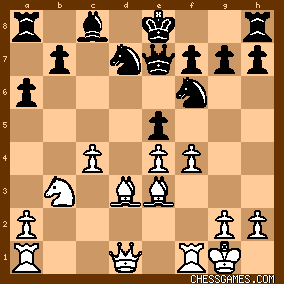
click for larger view16. fxe5?
As Fischer pointed out in his commentary, this was a mistake. Superior was Fischer's suggested 16. f5 [Actually, his commentary said "16. P-B5" using the older notation; I assume he was referring to 16. f5 and not 16.c5 which would not have been as good]. And probably better still was 16. Bc2 with perhaps a later c5. 16... Nxe5
17. Bc5

click for larger viewFischer still had the two Bishops, but Reshevsky's pieces were now getting developed and he had the sounder pawn structure. But Reshevsky now had to decide where to move his Queen. |
|
Oct-24-22
 | | KEG: Post III
17... Qd8
"?"--(Fischer)
17...Qc7 was--as explained by Fischer--definitely best. But the text hardly threw away Black's "advantage" as Fischer claimed because, on balance, White was surely better even before this second-best move (if 17...Qc7 18. Be2 Nxe4 19. Ba3 Nc3 20. Qd2 NxB+ 21. QxN f6 22. Qd2 White has lost a pawn but has more than sufficient compensation and clearly the better chances]. And even after 17...Qd8, Reshevsky was hardly lost, the position now being: 
click for larger view18. Bd4?
"?!"--(Muller)
The correct move was Muller's 18. Be2. Following Muller's suggested line: 18...QxQ (if 18...Bg4 19. BxB NfxB 20. Qd5 and then after 20...QxQ 21. exQ White has shed his primary weakness--his isolated c and e pawns--and has excellent winning chances in the complicated endgame) 19. RxQ Be6 and now 20. Nd4 [better than Muller's 20. Na5] leaving White with by far the better chances since Black cannot castle King's-side and White's pieces are all threateningly placed. After the text, Reshevsky had no serious problems 18... Qc7
19. Qd2
"!"--(Fischer)
19. Be2 was an excellent alternative.
19... Be6
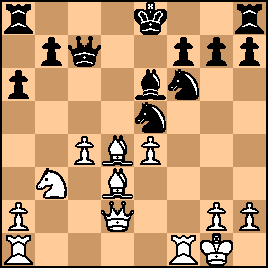
click for larger view20. Qf4
"!"--(Fischer)
Once again Be2 was a good--and probably superior--alternative. In either case, however, neither played would enjoy any substantial edge with Fischer's better development still balanced by his weak pawns. 20... Nfd7
21. Be2
Finally!
21... f6
Meeting, as Fischer pointed out, the threat of Nc5. 
click for larger view22. Bh5+
Fischer said he played this to provoke a weakness in the Black camp. But as will be seen, and as Fischer concedes he immediately recognized, his idea didn't quite pan out even after Resheveky played the hoped for weakening move. 22... g6
Reshevsky was fine after this, but probably simpler and better was 22...Bf7. 
click for larger view23. Be2
Fischer had to retreat, and this is better than 23. Bf3. As Fischer himself explained in his commentary, 23. Nc5? does not work because after 23...NxN 24. Qxf6 Black simply responds 24...Nf7 23... 0-0
Reshevsky at last was able to castle safely, and any edge Fischer had enjoyed was gone. 24. Rac1
Perhaps 24. c5 was better, but White's hope for a significant initiative had by now vanished in any case. 24... Rac8
25. c5 Nc6
"!"--(Fischer)

click for larger viewAs Fischer put it, Reshevsky had now gained "a little space." The game was now very much in the balance, with all three possible results still quite possible. |
|
Oct-24-22
 | | KEG: Post IV
26. Qe3 Nde5
27. Bb2 Rcd8
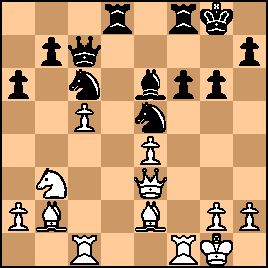
click for larger view29. h3
In connection with this move, the young Fischer made the following enigmatic comment "Bobby Fischer's Games of Chess": "So do me something." I don't get it.
29... Rd7
29. Kh1
I don't see the need for this. While it can hardly be called a "mistake," 29. a4 seems the easiest way to keep Black at bay. 29... Qd8
30. Rfd1 Rff7
Reshevsky could also have initiated a Rook exchange here. 31. a3
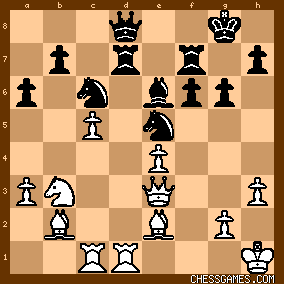
click for larger view31... RxR+
According to Fischer, Reshevsky could find no way to make progress in the middle-game and decided to reduce to an ending in which the position was also about even. The alternative was 31...BxN 32. QxB [Black would get some edge after 32. RxR QxR 33. QxB Qd2 34. Rc2 Qf4] 32. QxB Nd4, but then 33. RxN1 RxR 34. Qe3 allows White to regain the temporarily sacrificed exchange as a result of the potential skewer of the Rook on f7 and achieve an almost certainly drawn position after a few more exchanges. 32. RxR
32. BxR? Qd3 would be a catastrophe for White.
32... Rd7
33. RxR QxR

click for larger view34. Nd4
"!"--(Fischer)
34. Qc3 was another possibility, but the text looks like a simpler way to play for a draw (which was about all Fischer could reasonably hope for at this point. 34... NxN
Fischer could otherwise initiate a trade on his next turn. 35. QxN
35. BxN was also possible, but Fischer probably foresaw the drawn Bishops of opposite colors ending that most likely would now result. 35... QxQ
36. BxQ Kf7
37. Kg1 Bc4
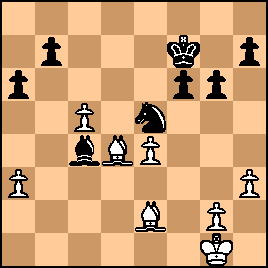
click for larger viewFischer rightly characterized this as "equivalent to offering a draw" since after the upcoming trade the game--despite the pawns Reshevsky was later able to snatch--was a clear draw. 38. BxN
As <Sastre> has pointed out on this site, 38. Bxc4+ would have been a blunder in light of 38...NxB. If here 39. a4, White gets crushed after 39...Nd2 and then is 40. e5 Nb3 winning a pawn whatever White does. If 39. Kf1 (the best chance but entirely inadequate to save the game), 39... Nxa3 should win. Fischer could also have played 38. Bd1 or even 38. Bf3 and likely would have drawn the game anyway, but the text is a more elegant way to wrap up the draw. 38... BxB
39. Bd6

click for larger viewReshevsky chose to play on for another 18 moves against his young opponent, but Bobby--as I will cover in my next post on this game--knew what to do in this Bishops of opposite colors ending to half the point. |
|
Oct-24-22
 | | KEG: Post V
39... Bd3
40. e5!

click for larger viewThis pretty much ensures the draw for White. If Reshevsky thought the young Fischer didn't know how to handle such endgames, 40. e5 let him know that the 14-year old knew what he was doing here. 40... f5
41. Kf2 g5
42. g3

click for larger viewThe adjourned position. As Fischer had said of the position several moves earlier, the outcome of the game was already clear. But play continued for another 15 moves. This allowed Fischer to demonstrate just how clearly drawn the game was. 42... Be4
43. Ke3 Bd5
44. Bc7 Ke7
45. h4
45. Ba5 was arguably simpler, but the text was a cute way to show just how futile winning efforts by either side were. 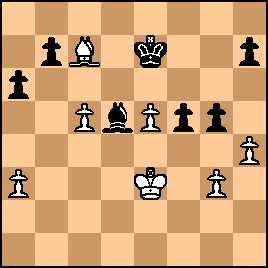
click for larger view45... f4+
46. gxf4 gxf4
47. f5
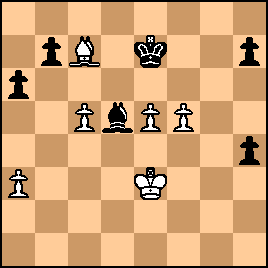
click for larger viewPlainly Reshevsky's two h-pawns will not get him anywhere. Anyone other than a computer should be able to see that instantly. 47... h3
48. Bd6+ Kf7

click for larger viewAs Muller has pointed out, it is still possible--if White gets really sloppy--to lose this game: 49. e6+ Kf6 50. Kf4?? [blocking his own Bishop from stopping the Black h-pawn] h2 and Black wins. But Bobby wasn't falling for any such nonsense: 49. Kf2 Be4
49...h2 doesn't work in light of 50. e6+ Kf6 51. Bxh2 with an obvious draw. 50. Kg3
<wall> has asked whether Fischer would have had winning chances with 50. e6+ Kf6 51. e7 Kf7 52. f6. The answer is: No. Black just plays 52...Bc6. And an even clearer way for Black to stymie any such idea is 51...Bc6 as pointed out by <Hanzo Steel> Play might then continue 52. Kg3 Kxf5 53. Kxh3 Ke6 with an easy draw. 50... Bxf5
Fischer could afford to part with this pawn (and soon enough with his e-pawn as well) since his dark-square Bishop holds the Queen-side and Reshevsky's h-pawns are paper tigers. 
click for larger view51. Bc7
Setting up an iron-clad formation on the Queen-side. 51... Bd7
52. Ba5 Ke6
53. Bb4
<wall> asks why not try to save the e-pawn with 53. Bc7. Fischer was probably concerned that Reshevsky might have something after 53...Kd5 54. Bd6 Kc4 with winning chances for Black when the White a-pawn falls. By contrast, Fischer's move ended any illusion that Black might have any way to play for a win, the position now being: 
click for larger view53... Kxe5
54. Kh2 h5
55. Kg3 Kd4
56. Kh2 h4
57. Kg1
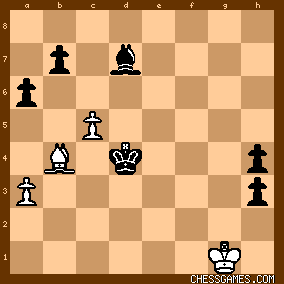
click for larger viewDrawn
<pepechuy> has a source that gives 57. Kh1 as Fischer's final move. Either move is fine. Fischer's 1958 book "Bobby Fischer's Games of Chess" has 57. Kg1, and his diagram of the final position has his King on g1. Every other source with which I am familiar also has 57. Kg1, so I must assume that is what Bobby played. |
|
|
|
|





